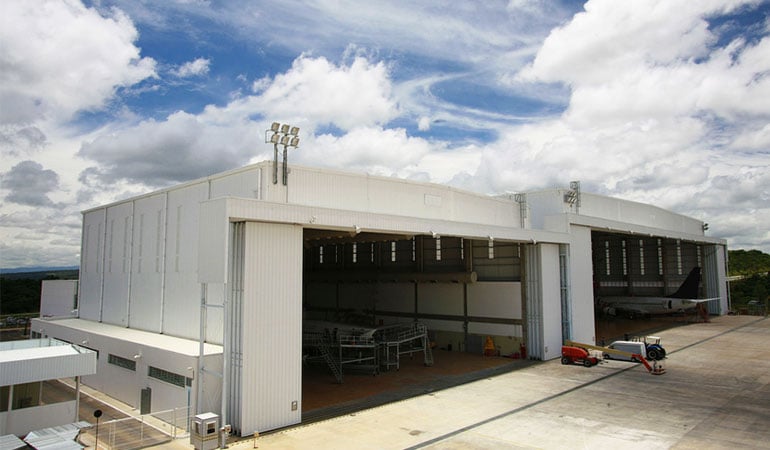Airplane and helicopter hangars shoulder a tremendous burden; they protect some of the most delicate, sensitive, and valuable machines that any person or company may own. Accordingly, the process of deciding on a particular hangar design and manufacturer is a serious decision which should not be taken lightly. There are a number of questions which need to be answered in order to ensure that the correct design is selected such as size, materials, environmental factors, and even permanency. It is up to each individual operator to determine their specific needs, but here are the 10 aircraft hangar manufacturers that you should know about and consider for future expansion.
1. Rubb Building Systems: modular hangars with high adaptability
Rubb offers a unique building systems solution to companies which may not want to commit to a full-scale permanent hangar yet wish to maintain the storage capacity of a full size hangar or Maintenance Repair Overhaul (MRO) facility. Rubb buildings are an excellent solution, consisting of a galvanized steel skeleton covered in premium PVC coated fabric providing a service life in excess of 30 years. Rubb offers hangar sizes from small general aviation and helicopters all the way through wide body jets should the client request it. The great benefit of this type of hangar system is the modularity, adaptability, and very quick time of completion.
2. Erect-A-Tube: hangar manufacturer for light aviation
Illinois-based Erect-A-Tube has a long history in the aircraft hangaring business, which includes being the original designer and provider of electric bi-folding doors. Erect-A-Tube offers hangars in “T” and rectangular configurations, consisting of a steel frame with corrugated sheet metal skin which is very typical in general aviation hangars. The main limitation with Erect-A-Tube is size; they specialize in light aviation through corporate jets, so they are out of the running for anyone needing to house an aircraft much larger than a Citation or a King Air.
3. Fulfab: hangars built in merely three weeks
Based in the “Rust Belt”, the heart of steel country in the United States, Fulfab hangars enjoys a long history of 60 years in business. A direct competitor of Erect-A-Tube, Fulfab offers very similarly sized hangars geared towards general aviation and light executive turbine aircraft. They offer a tremendous advantage over some competitors though in that all of their buildings are pre-engineered and pre-fabricated in-house so they are erected very quickly on site. The typical build time of a 10-pack of T-hangars is only three weeks according to Fulfab.
4. REIDsteel: a century in hangar manufacturing
REIDsteel is a U.K. based business which specializes in building steel hangars of all sizes, and the first mentioned here which provides permanent steel hangars for large aircraft and military operations. REIDsteel has been in the business for 98 years so they are no newcomer to the game, and they boast buildings in over 130 countries to include Africa, the Middle East, Asia, and so on. REID does projects of all size and scope, from small bespoke hangars for private aircraft to gigantic wide span hangars to accommodate massive Boeing 747-400 and Airbus A380. They also offer cantilevered hangars which allow owners and operators to move aircraft in and out without having to work around intrusive support columns, and doors can be opened independently to accommodate only the selected aircraft vice opening all doors on a hangar to move only one aircraft.
5. Röder HTS Höcker GmbH: manufacturing with precision
HTS hails from Kefenrod, Germany, and offers a host of aircraft structures for corporate aviation, as well as military and defense. They not only build airplane hangars, but also build terminal buildings, canopies, baggage handling areas, and more. Similar to Rubb Building Systems, HTS specializes in semi-permanent structures which are precisely engineered using AutoCAD and then machined using CNC processes, ensuring exacting fit and finish every single time. These design processes also ensure that a product is not only exact, but infinitely adaptable. HTS can make a semi-permanent hangar of practically any size, and materials are ready for shipment often in as little as 15 days. These structures can be assembled and are fully operational in just a few weeks, versus the months that are expected when building a traditional steel structure.
6. Heavy Structures: hangar manufacturer for MROs and many more
Heavy Structures, a division of BlueScope Buildings North America, Inc., holds an impressive portfolio of permanent hangars built all over North America. They have built major MRO facilities for JetBlue, Southwest Airlines, SkyWest Airlines, and Continental Airlines, and the crowning achievement seems to be their 207,000 sq. ft. arched hangar for the U.S. Air Force Strategic Air Command museum.
7. Allied Buildings: Global hangar manufacturer with custom designs
With companies like Space-X in their portfolio, it can be reasonably assumed that Allied Buildings has a solid reputation and delivers a quality product. Allied has completed projects in North America, Latin America, the Caribbean, Africa, and Asia, which is quite an accomplishment for a company that is only 14 years in existence. Allied custom designs their hangars individually to fit their customer's needs, whether it is housing a Gulfstream III, or components of a rocket, and they will gladly ship worldwide.
8. Banyan Steel Arch Systems: quick, economical and safe
Steel arch hangars were once commonplace at airports, but their popularity has waned in recent years. However, arch hangars offer advantages that no other design can. First, they are very strong by design. There are no or very few right angles for wind to catch so they are an excellent option in severe weather zones. Second, they are very simple and economical since the design does not necessitate the complex web of steel framing, which also makes assembly very quick and feasible in more austere locations. Third, since there are no support beams crisscrossing the ceiling there is nowhere for birds to nest which essentially eliminates birds in the hangar. Banyan is located in Indianapolis, Indiana, and ships worldwide.
9. J&M Steel: newcomer in the hangar manufacturing industry
Another relative newcomer to the scene is J&M Steel from Georgia. Having only been in business since 2004, they have also established a healthy reputation and a strong showing in large hangars, including an isochronal inspection hangar for C-130 aircraft in New Mexico, a UAS hangar at the Dugway Proving Grounds in Utah, and miscellaneous airport support buildings at Salt Lake City International airport. These are fairly standard steel truss buildings with steel sheet skin, and J&M custom designs each one tailored to the customer.
10. BigTop Manufacturing: sturdy materials and many different sizes
Rounding out the field, BigTop offers fabric hangar structures which are arched, much like those made by Banyan. BigTop offers open-ended sun shades, which allows aircraft to taxi through and offers protection from the sun and some environmental elements, as well as full-size enclosed hangars. To reiterate the utilitarian nature of fabric, semi-permanent structures, BigTop employs a proprietary tensioned fabric and steel system which is windproof, waterproof, and flame-retardant. Installation is very fast, and can even be accomplished with unskilled labor due to the simplicity of the process. Fabric structures can be made as narrow as 20 ft/6 m to accommodate general aviation, and all the way out to 174 ft/53 m in width, wide enough for even most wide-body jets which is an attractive concept in the event that a permanent hangar is closed for renovation. BigTop hangars are available in a variety of heights up to 72 ft/22 m, suitable even for blimp storage!
Apart from hangar manufacturers: what type of hangar is best for you?
It is important to bear in mind certain factors when you are considering building an airplane hangar or helicopter hangar. The most important consideration is how permanent it is intended to be. Even though fabric hangars have a service life in excess of two decades, if you and your company intends to house aircraft and operate out of a given airport as a long-term, permanent basis, it will likely serve you the best to consider a steel structure. However, if you are expanding faster than anticipated, or have had to move operations for an unforeseen reason then a fabric hangar may be the best option. Specifically speaking towards the helicopter community, fabric helicopter hangars offer tremendous flexibility for operations, particularly ambulatory services. Fabric hangars can be erected very quickly and are very sturdy, allowing mobile helipads to be established extremely quickly.
Contacting hangar manufacturers: How do you buy an aircraft hangar?
A questions which comes up is just how exactly do you go about ordering a hangar? Each company is different, but with the advent of global commerce via the internet many companies ship globally directly from their factories, effectively cutting out any cost associated with intermediaries. Some companies provide labor as well, although these seem to be more of the smaller, regional companies since the cost of sending a team across the world for months on end would be staggering. Since these manufacturers create tailor-made products using advanced AutoCAD process and CNC machining, it makes the most sense to design the building, cut it precisely to specifications, crate it and ship it direct to the location and have the customer source local contractors for assembly from the blueprints.
Costs of an aircraft or helicopter hangar
Cost varies on these structures and manufacturers seldom post prices online or in brochures because they really need to estimate each project separately since there are so many factors in play. That being said, fabric structures generally vary between $10-$50 USD per square foot ($107-$538 USD per square meter), while traditional steel construction falls between $40-$200 USD per square foot ($430-$2,153 USD per square meter), and erring on the high side of those numbers is prudent.
Conclusion to hangar manufacturers and the features of hangars
A new temporary or permanent hangar is an important part of your business. Make sure your equipment fits it, because quality GSE is what you need to keep both your aircraft and your hangar safe. Read even more insights on efficient ground handling now in our ebook. Get you free copy right now!



Comments